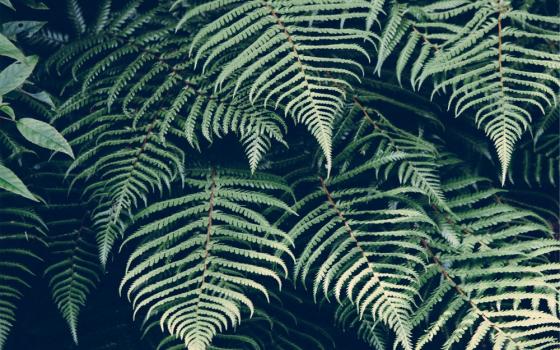Nature is fickle. Just when you think you know something about something else, say another human person, a tree or your new cat, you are taken off guard because the other can spring from the plane of the predictable and do surprising things. Just about a month ago, we adopted two six-month-old kittens who had struggled through the first few months of life. We brought them home from the shelter thinking that these two would be fragile and weak, but in a month’s time and with lots of food and rest, they have come alive. Despite their fragile beginnings, they are playful and carefree and remind me of nature’s creative resiliency, as they romp down the hallway throwing their toys into the air, as if the abandoned alley never existed.
We expect nature to be fixed and predictable; yet, we are constantly challenged by nature’s subtle playfulness. Buddhists speak of nature’s impermanence. Things change from moment to moment, never ceasing in the endless flow of life. Hindus speak of lila or divine creative playfulness throughout the cosmos. Despite our good will to preserve nature from the perils of destruction, nature cannot be preserved because the “nature” of nature is to change, to birth new life, life unto life, which is why nature is our mother.
The most apt word to describe nature is relationship. Life is relational all the way back to the Big Bang. A modern commentary on the Big Bang might begin: “In the beginning is relationship and out of energized relationships new life emerges.” The physical universe is not a collection of fixed objects but a luminous web of interconnectedness. Space is not an empty container for atoms to bounce around like billiard balls in the air; rather, space is replete with overlapping fields of energy. Nature thrives on local networks of interlocking energy fields.
The rise of quantum mechanics and quantum entanglement, the discovery of open systems, all point to intrinsic relationality in the physical world. Things are constantly appearing and disappearing as if everything, from quarks to compounds, is dancing in the folds of space-time. Nature is not a lump of clay or inert building blocks. Rather, what we call “nature” is a zig-zag, a highly charged, light-filled electronic three-ring circus of spontaneously creative matter darting from one energy level to another, as the unyielding force of attraction within nature continuously draws elements together, center to center. Love, Teilhard de Chardin suggested, is the true stuff of the universe.
If nature is relational, bonded realities of creative events, then nature is informational as well. Relationships are not static bridges from one entity to another but channels of flowing energy or fields of light in which the exchange of ions or jumps in energy levels convey patterns of information. Energy flow is particle talk, as if particles might say to one another, “Let’s stay for a while,” or “It’s time to converge.” There is a mindfulness in nature that vitalizes the direction of nature’s flow. In the Newtonian cosmos, matter had no purpose or intention; it held no room for spirit or consciousness. The physical world was set against the mental and, in turn, the mental came to be seen in terms that were not physical. Today we know that consciousness is integral to all aspects of cosmic life. The universe is brimming with consciousness all the way from the most elementary particles to vast galaxies, from the Big Bang to Einstein.
The openness of nature to creativity means that no aspect of nature can be constrained by form or boundaries. Given a sufficient amount of time and the right conditions, created entities will transcend their limits, especially if the limits constrain rather than liberate the element/subject. Transcendence means to go beyond the boundaries of self-existence. In a sense, transcendence complements creativity because the movement beyond self means enhancing the capacity for new relationships and thus for new things to happen. The combination of creativity and transcendence enables the things of nature to evolve, to move to new levels of complexity and thus new degrees of relatedness.
Non-human nature has a built-in capacity to let go so as to flow into new life; perhaps we might say that it has an intrinsic forgiveness factor. Relationships can be damaged because things happen, but there is a real propensity for bonding and group coherence among many different types of biological species. I watch my two kittens, for example, fight over food or attention and shortly after being embroiled in conflict, they reunite and sleep in the same bed.
It is interesting that Christianity is based on nature, actually a union of natures. The Chalcedonian formula describes the person of Jesus Christ as two natures, truly God and truly human, one in nature with the Godhead and one in nature with humankind, a mysterious unity of natures that could be described as a hybridization of divinity and humanity. God’s deeply relational creative love is poured out through the divine Word into space-time, rendering this creative, birthing process of nature an entangled image of divine love-energy. The spontaneous, creativity and openness of nature reflects the creativity and openness of God.
In this respect, it is easy to see why Jesus was not so rigid about nature; his life exemplified the openness of nature to new life. Indeed, the Gospels reorient human nature toward Godly fulfillment by unleashing human religiosity from the constraints of duty, law, tradition and exclusive group mentality. God loves nature, and anything that opposes nature opposes God.
Lent is a good time to reflect on what it means to be part of nature. When do we become rigid and entrenched in our ideas? How do we try to control our relationships? The season of Lent calls us to check our human nature and our capacity for life-giving relationships. When we are unconscious of this capacity we are prone to cut ourselves off from others, especially if we have been hurt. Lenten conversion is centered on forgiveness. Jesus tells Peter that he is to forgive not merely seven times (a perfect number) but “seventy-times-seven” (Mt 18:21), a seemingly endless number of times.
Forgiveness is a “Big Bang” attitude; instead of allowing past hurts to absorb us in a black hole of unhappiness and inner turmoil, we let go and return the good that belongs to the other who offended us. We cannot undo past hurts or injustices but we can create new bonds of relatedness, embarking on a new level of life open to new life in God. Forgiveness is creative; it has the potential to birth new life. It liberates and revitalizes us for life, opening us up to the wonders of the present moment, releasing within us the creativity and playfulness of our human nature. Forgiveness restores love within us in a way that we can begin to see the world with new eyes. One who forgives realizes that the past cannot be undone and that the only real moment of life is now. Radical forgiveness is radical loving, making a choice for life, to be part of this dynamic evolution toward more being and consciousness, to help create a world of unity, justice and peace. In the words of Marianne Williamson, “The practice of forgiveness is our most important contribution to the healing of the world.”
We humans can easily fall prey to being “victimized,” resentful, angry, self-righteous and therefore seldom at peace with one another because we cannot forgive one another. Forgiveness begins in the heart. We cannot forgive others if we cannot forgive ourselves and let go of our divisive thoughts. To heal our inner woundedness is to know God’s power of love within us which is stronger than death, a love overflowing with future life. God is the power of the future, and one who lives in God rests on the future.
Jesus does not ask us to preserve nature but to return to nature: “Look at the birds of the air, they do not sow or reap or store away in barns, and yet your heavenly Father feeds them. Are you not much more valuable than they?” (Mt 6:26) We are to learn the patterns of life that give birth to new life. Nature can teach us how to rise from the dead because the whole of nature reveals the astonishing power of the risen Christ. So let us get out of the rut of unforgiveness. Let us return to the playful creativity of nature and practice resurrection.
[Ilia Delio, OSF, a Sister of St. Francis of Washington, D.C., is Haub Director of Catholic Studies and Visiting Professor at Georgetown University. Her recent publications include From Teilhard to Omega: Cocreating an Unfinished Universe and The Unbearable Wholeness of Being: God, Evolution and the Power of Love.]

